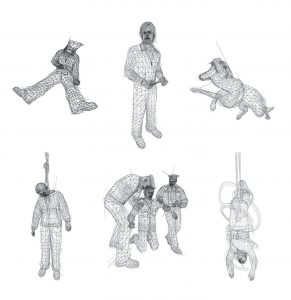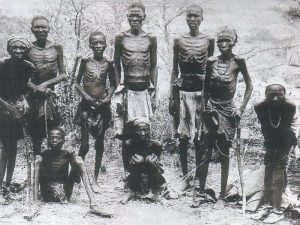IS AFROPEAN A PROJECT TOWARDS EMANCIPATION? PART 3: COLONISED BODIES
Written by CS Bastos Gomes Pinto
In ‘Afropean: Notes from Black Europe’, Johny Pitts links the marginalisation of present-day African-descent peoples to colonial history. The former Royal Museum for Central Africa (in Belgium), King Leopold II, the human zoos, and the Herero Genocide, are among the historical places, figures, and events mentioned by the author concerning the atrocities committed by colonial European powers.
Regarding the Herero, Pitts describes:
“(…) after anti-colonist rebellions, German troops massacred 70 per cent of the Herero tribe of modern-day Namibia (at least 25,000 people) and performed horrific scientific experiments on Herero men and women left starving and riddled with scurvy in concentration camps, injecting them with arsenic and opium, and using their body parts for the type of eugenics and craniometry that would foreshadow Nazi Germany’s crimes against humanity.”
The following paragraphs aim to understand the relationship between sovereignty and violence exerted over colonised bodies.
Thomas Blom Hansen and Finn Stepputat (in Sovereign Bodies: Citizens, Migrants, and States in the Postcolonial World) highlight that the domination of the non-European world was intrinsic to the Western European formation of sovereign state and nation. Although not uniformly nor at the same pace, sovereignty “had already become an explicit element” in the colonised world (namely in the Americas) by the time of the European ‘Westphalia’ (1648) – by the time European sovereign states start to be conceived (see Couze Venn in Neoliberal Political Economy, Biopolitics and Colonialism: A Transcolonial Genealogy of Inequality). According to Hansen and Stepputat, ‘sovereignty’ can be interpreted in International Relations as de facto control of states or institutions over their populations and territory. This control must be recognised and legitimated by external sovereigns. Yet, this duo goes beyond this definition and place the “exercise of violence over bodies and populations” within the definition of sovereignty.
In the 18th century, democracy made ‘the people’ citizens and part of the ‘body politic’ of the sovereign state. In other words, the state became representative of the people and, consequently, responsible for their “welfare, economy and morality” (in Sovereign Bodies: Citizens, Migrants, and States in the Postcolonial World). This relationship contributed to an increased sense of patriotism among the citizens, culminating with the emergence of the modern nation-state. Benedict Anderson (Imagined Communities: Reflections on the Origin and Spread of Nationalism), in its turn, emphasises the development of ‘print-capitalism’, which worked to gradually strengthen the use of national languages and facilitate the homogenisation/naturalisation of cultural notions of the nation (such as “skin-colour, gender, parentage and birth-era”). The point is that the modern sovereign state became the “political-institutional embodiment” of the “national consciousness” (see Pheng Cheah in Spectral Nationality: The Living On of the Postcolonial Nation in Neocolonial Globalization).
But to better understand the effects of colonial sovereignty over bodies (such as those of the Herero people), we need to recognize that sovereignty was exerted on the colonised world differently. The colonised were deemed non-citizens. Hansen and Stepputat, grounded in the theories of Carl Schmitt and Giorgio Agamben, stress that colonial sovereignty devised subjects who were permanently in a ‘state of exception’, who were therefore under a different form of rule than in Europe. And since sovereignty is always an “unstable project”; they add, colonial sovereignty – allied to the reinforcement of racial superiority, concepts of civilization, and the need to dominate “indigenous forms of rule and sovereignty” – intensified and systematised demonstrations of excessive violence in the colonised world.
Agamben (in Homo Sacer), for instance, interprets Foucault’s idea of ‘biopolitics’ as natural life (‘bare life’) being included in “the mechanisms and calculations of State power” so as “the production of a biopolitical body is the original activity of sovereign power.” For Achile Mbembe (in Necropolitics), slavery was “one of the first instances of biopolitical experimentation” and the sugar-cane plantations became manifestations of the ‘state of exception’. He utilises the concept of biopolitics to emphasise that colonial sovereignty legitimates hierarchies and “the enactment of differential rights to differing categories of people for different purposes within the same space.”. Influenced by Schmitt and Agamben’s works, as well, Mbembe sees sovereignty in the colonial world as power exercised outside the law.

In colonised Angola, for example, the population was divided into indigenous, assimilated, and full-citizens (the ‘white’ colonisers) (see Fernando Arenas in Lusophone Africa – Beyond Independence). Forced labour, corporal punishment and other abuses were legitimised against the indigenous peoples. A 1957 Portuguese native code (Estatuto dos Indígenas Portuguese da Guiné, Angola e Moçambique) attempted to put an end to forced labour, but it still specified that the indigenous were in a special legal position due to their inferior level of civilization. Pitts likewise recounts finding inside the Royal Museum an original agreement which African chiefs were most probably forced to sign. For “one piece of cloth per month”, African chiefs had agreed to:
“give up to the said [Belgian] Association the sovereignty and all sovereign and governing rights to all their territories… All roads and waterways running through this country, the right of collecting tolls on the same, and all game, fishing, mining and forest rights”
Nevertheless, Hansen and Stepputat state, the colonies were included as “appendices to the metropolitan [nation] states, as essential sources of trade, workforce, and soldiers”. Using Agamben’s words, they were both ‘included’ and ‘excluded’. Colonised indigenous people were European subjects without being part of European nation-states.
Mbembe equally underlines that the power to decide between life or death (defined as necropower) is the “ultimate expression of sovereignty”. Sovereignty defines who deserves to live, who matters and who does not. The theorist emphasises that “absolute lawlessness stems from the racial denial of any common bond between the conqueror and the native”. Because the natives’ modes of being were closely connected to nature or were incomprehensible to the colonisers; according to Hannah Arendt (cited by Mbembe), the natives were perceived as human beings:
“who lack the specifically human character, the specifically human reality, so that when European men massacred them they somehow were not aware that they had committed murder.”
By reducing the Herero to ‘bare life’, the Herero genocide was the ultimate expression of colonial German sovereignty. As mentioned by Pitts regarding this genocide, and both Arendt and Mbembe, the racialised technologies and methods of control over colonised bodies ended up being transferred to Europe, The Holocaust being the most documented example.
Colonialism has also impacted modern European institutions such as the police (see Florian Bobin in How Colonialism Shaped Policing in France and Connor Woodman in How British police and intelligence are a product of the Imperial Boomerang Effect). Furthermore, studies have even dislocated the origins of modernity and capitalism to regions of the colonised world (see Hillary McD Beckles in Capitalism, Slavery and Caribbean Modernity). 16th-century Caribbean sugar-mills opened the way for a social, political, and economic shift both in the region and in the colonial metropolises. However, none of this would have been achieved without the enslavement, forced labour, and dehumanisation of African and African-descent peoples. The differentiation, disciplining, othering, and ordering of bodies are intrinsic and crucial to capital accumulation – a form of ‘racial capitalism’ (see Gargi Bhattacharyya in Rethinking racial capitalism: questions of reproduction and survival, and Satnam Virdee in Racialized capitalism: An account of its contested origins and consolidation). For Michel Foucault (in Society Must Be Defended: Lectures at the Collège de France, 1975–1976), racism is a technology of power inseparable from the “old sovereign right to kill”.
“In a normalizing society, race or racism is the precondition that makes killing acceptable…. So you understand the importance . . . of racism for the exercise of such a power: it is the pre-condition for exercising the right to kill.”
Any sovereign state which exercises its “right to kill” is, therefore, necessarily racist.
To conclude, in 1949, Aimé Césaire (in Gary Wider, Race, Reason, Impasse: Césaire, Fanon, and the Legacy of Emancipation), criticised colonial France for the “legacy of emancipation (of slavery)” remaining “incomplete and unresolved”, since “racism, colonial violence and the legal order” were far from being over. Today, as then, African and African-descent peoples continue to be vulnerable to racial capitalism, new forms of colonialism and to the legacies of slavery. They still struggle for full emancipation, for sovereignty over their own lives.




